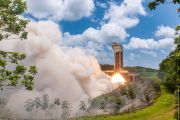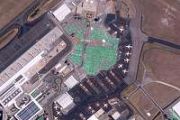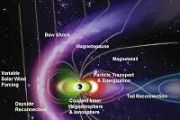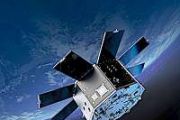
Copernical Team
Astronomers make rare exoplanet discovery
 Astronomers have made the rare discovery of a small, cold exoplanet and its massive outer companion - shedding light on the formation of planets like Earth.
The findings include a planet with radius and mass between that of the Earth and Neptune, with a potential orbit around its host star of 146 days. The star system also contains an outer, large companion, 100 times the mass of Jupiter.
Astronomers have made the rare discovery of a small, cold exoplanet and its massive outer companion - shedding light on the formation of planets like Earth.
The findings include a planet with radius and mass between that of the Earth and Neptune, with a potential orbit around its host star of 146 days. The star system also contains an outer, large companion, 100 times the mass of Jupiter. Tianzhou 6 cargo spacecraft to return to Earth
 The Tianzhou 6 cargo spacecraft departed from the Tiangong space station on Friday afternoon and is set to return to Earth soon, according to the China Manned Space Agency.
The agency said in a brief release that the robotic craft undocked from Tiangong at 4:12 pm and entered into the solo-flight mode.
During the atmospheric reentry process guided by ground controllers, most of the s
The Tianzhou 6 cargo spacecraft departed from the Tiangong space station on Friday afternoon and is set to return to Earth soon, according to the China Manned Space Agency.
The agency said in a brief release that the robotic craft undocked from Tiangong at 4:12 pm and entered into the solo-flight mode.
During the atmospheric reentry process guided by ground controllers, most of the s MEASAT Partners with SpaceX as Official Reseller for Starlink Services in Key Markets
 In a significant move to expand its satellite service offerings, MEASAT Global Berhad, Malaysia's leading satellite solutions provider, has entered into a strategic partnership with Space Exploration Technologies Corp. (SpaceX). As per the agreement finalized in December 2023, MEASAT has become the Official Authorised Reseller for SpaceX's Starlink Hardware and Services in the markets it serves.
In a significant move to expand its satellite service offerings, MEASAT Global Berhad, Malaysia's leading satellite solutions provider, has entered into a strategic partnership with Space Exploration Technologies Corp. (SpaceX). As per the agreement finalized in December 2023, MEASAT has become the Official Authorised Reseller for SpaceX's Starlink Hardware and Services in the markets it serves. New instrument to capture stardust as part of NASA mission
 Scientists and engineers at the CU Boulder will soon take part in an effort to collect a bit of stardust-the tiny bits of matter that flow through the Milky Way Galaxy and were once the initial building blocks of our solar system.
The pursuit is part of NASA's Interstellar Mapping and Acceleration Probe (IMAP) mission to explore our solar neighborhood-decoding the messages in particles fro
Scientists and engineers at the CU Boulder will soon take part in an effort to collect a bit of stardust-the tiny bits of matter that flow through the Milky Way Galaxy and were once the initial building blocks of our solar system.
The pursuit is part of NASA's Interstellar Mapping and Acceleration Probe (IMAP) mission to explore our solar neighborhood-decoding the messages in particles fro Earth-sized planet discovered in 'our solar backyard'
 A team of astronomers have discovered a planet closer and younger than any other Earth-sized world yet identified. It's a remarkably hot world whose proximity to our own planet and to a star like our sun mark it as a unique opportunity to study how planets evolve.
The new planet was described in a new study published this week by The Astronomical Journal. Melinda Soares-Furtado, a NASA Hub
A team of astronomers have discovered a planet closer and younger than any other Earth-sized world yet identified. It's a remarkably hot world whose proximity to our own planet and to a star like our sun mark it as a unique opportunity to study how planets evolve.
The new planet was described in a new study published this week by The Astronomical Journal. Melinda Soares-Furtado, a NASA Hub ASU talk will examine ethical questions surrounding life in space
 What is the impact of extended space travel on the human body? Can space travel bring life-threatening extraterrestrial contaminants back to Earth? Do we spend money on space exploration and research when there are problems on Earth to solve?
These questions and more will be tackled at an upcoming BioEthics Breakfast Club talk titled "Life in Space." The event takes place from 9 to 10 a.m.
What is the impact of extended space travel on the human body? Can space travel bring life-threatening extraterrestrial contaminants back to Earth? Do we spend money on space exploration and research when there are problems on Earth to solve?
These questions and more will be tackled at an upcoming BioEthics Breakfast Club talk titled "Life in Space." The event takes place from 9 to 10 a.m. A Big Cosmological Mystery
 The discovery of a second ultra-large structure in the remote universe has further challenged some of the basic assumptions about cosmology.
The Big Ring on the Sky is 9.2 billion light-years from Earth. It has a diameter of about 1.3 billion light-years, and a circumference of about four billion light-years. If we could step outside and see it directly, the diameter of the Big Ring would
The discovery of a second ultra-large structure in the remote universe has further challenged some of the basic assumptions about cosmology.
The Big Ring on the Sky is 9.2 billion light-years from Earth. It has a diameter of about 1.3 billion light-years, and a circumference of about four billion light-years. If we could step outside and see it directly, the diameter of the Big Ring would Japan successfully launches spy satellite
 Japan on Friday successfully launched a rocket with a payload of an intelligence-gathering satellite to improve its abilities to monitor North Korea and natural disasters, as several Asian nations seek to put spy orbitals into space.
The H2A rocket launched from the Tanegashima Space Center located on the southern Tanegashima Island at 1:44 p.m. local time Friday.
"The rocket fle
Japan on Friday successfully launched a rocket with a payload of an intelligence-gathering satellite to improve its abilities to monitor North Korea and natural disasters, as several Asian nations seek to put spy orbitals into space.
The H2A rocket launched from the Tanegashima Space Center located on the southern Tanegashima Island at 1:44 p.m. local time Friday.
"The rocket fle Indonesian MoD Partners with BlackSky for Advanced Space-Based Intelligence Services
 BlackSky Technology Inc. (NYSE: BKSY), a leader in real-time geospatial intelligence and satellite imaging, has recently announced its significant contract win from PT Len, exceeding $1 million, to support the Indonesian Ministry of Defense. This multi-year agreement underscores the growing need for immediate, high-frequency imagery and analytics services in defense operations.
Brian E. O'
BlackSky Technology Inc. (NYSE: BKSY), a leader in real-time geospatial intelligence and satellite imaging, has recently announced its significant contract win from PT Len, exceeding $1 million, to support the Indonesian Ministry of Defense. This multi-year agreement underscores the growing need for immediate, high-frequency imagery and analytics services in defense operations.
Brian E. O' NASA's Cryo Efforts Beyond the Atmosphere
 Establishing sustained operations at the Moon and Mars presents a multitude of opportunities and challenges NASA has yet to encounter. Many of these activities require new technologies and processes to ensure the agency is prepared for its ambitious Artemis missions and those beyond.
One of those challenges is working with cryogenic fluids, meaning fluids existing in a liquid state between
Establishing sustained operations at the Moon and Mars presents a multitude of opportunities and challenges NASA has yet to encounter. Many of these activities require new technologies and processes to ensure the agency is prepared for its ambitious Artemis missions and those beyond.
One of those challenges is working with cryogenic fluids, meaning fluids existing in a liquid state between 
































